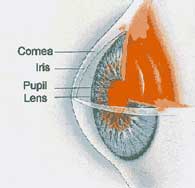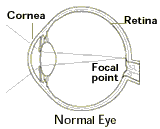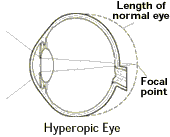For more information, or to schedule an appointment for consultation or SLT cold laser glaucoma surgery at our practice, please fill out the contact form below. Dr. Jindra and the staff are more than happy to address any concerns you may have.
Dr. Lawrence F. Jindra
5 Covert Ave
Floral Park, New York 11001
United States of America
Ph / +1.516.616.1710
|
|
The Myopic Eye
|
The Hyperopic Eye
|
Astigmatism and PresbyopiaOther common vision problems include astigmatism and presbyopia. With astigmatism the curvature of the cornea is uneven, causing a distortion of images. This distortion is especially noticeable after dark and with bright lights. With astigmatism, objects at all distances appear blurred. Presbyopia is caused by a loss of focusing flexibility in the eye and affects everyone, often starting in the mid-forties. This makes it difficult to view objects up close while wearing corrective eyewear for nearsightedness. People with this condition often wear reading glasses and bifocals (glasses that focus different ways for up close and distance viewing). |
The Anterior Chamber
 The anterior chamber is a small space in the front of the eye. It is a space between the cornea and the iris. The hole in the iris is called the pupil. Behind the iris and pupil is the lens. In order to understand glaucoma, it is important to understand how all the parts of the anterior chamber work together The anterior chamber is filled with a fluid called the aqueous humor, which bathes the cornea and the lens. The aqueous brings oxygen and nutrition to the lens and cornea, and also removes waste products.
The anterior chamber is a small space in the front of the eye. It is a space between the cornea and the iris. The hole in the iris is called the pupil. Behind the iris and pupil is the lens. In order to understand glaucoma, it is important to understand how all the parts of the anterior chamber work together The anterior chamber is filled with a fluid called the aqueous humor, which bathes the cornea and the lens. The aqueous brings oxygen and nutrition to the lens and cornea, and also removes waste products.
The aqueous fluid is continuously being produced by a tiny organ called the ciliary body located behind the iris. From there the aqueous flows forward through the pupil and enters the anterior chamber like air pumped into a tire, the aqueous keeps the eye "pumped up" to just the right pressure. The pressure inside the eye is called the intraocular pressure. The right amount of pressure depends on the correct balance of aqueous fluid going into, and the ease with which it flows out of, the anterior chamber. The aqueous humor empties out of the eye through a special drain located in the corner or angle where the cornea and iris meet in front of the iris. This drain is called the trabeculum meshwork. The balance between the amount of aqueous fluid produced and the ease with which it flows out through the trabecular meshwork is very important. If too much aqueous is being made, or if it cannot drain fast enough or if the drain is not working properly, the pressure inside the eye will rise. The pressure in the eye can never rise so high that the eye will burst, but it can rise high enough to damage the optic nerve and cause loss of vision. This is glaucoma.
 The normal eye works much like a camera, using a lens to focus an image onto the retina at the back of the eye, where the light rays join together at a precise focal point, and near and distant objects appear sharp and clear.
The normal eye works much like a camera, using a lens to focus an image onto the retina at the back of the eye, where the light rays join together at a precise focal point, and near and distant objects appear sharp and clear. The nearsighted eye (myopia) is somewhat longer than the normal eye. This causes the light rays to focus at a point in front of the retina, resulting in a blurry view of distant objects.
The nearsighted eye (myopia) is somewhat longer than the normal eye. This causes the light rays to focus at a point in front of the retina, resulting in a blurry view of distant objects. The farsighted eye (hyperopia) is shorter than the normal eye. Light rays are aimed at a focus point behind the retina causing blurring of objects viewed up close.
The farsighted eye (hyperopia) is shorter than the normal eye. Light rays are aimed at a focus point behind the retina causing blurring of objects viewed up close.